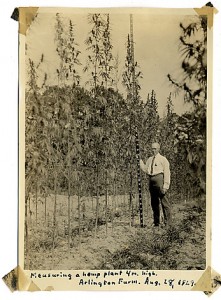 According to a report from the Washington Post, the land where the U.S. Pentagon stands was once occupied by fields of hemp.
According to a report from the Washington Post, the land where the U.S. Pentagon stands was once occupied by fields of hemp.
Lyster H. Dewey was a botanist for the U.S. Department of Agriculture from the late 19th to early 20th century. Dewey tended daily to government fields known as the Arlington Farm. That’s right, Dewey was growing hemp for the U.S. Government. A portion of the fields were later used by the War Department to construct the Pentagon.
In his diaries spanning from 1896 to the year of his death in 1944, Dewey detailed his operations at the Arlington Farm as early as 1914. He talks of inspecting, growing, and harvesting hemp, and this picture found with the diaries shows Dewey next to hemp stalk standing as high as 13 ft. “Measuring a hemp plant 4 m. high. Arlington Farm. Aug, 28, 1929.”
We’ve already detailed the advantage of hemp production over cotton, but it was actually the paper industry that suppressed the cultivation of cannabis hemp in the 1930’s. According to Jack Herer’s The Emperor Wears No Clothes, paper mogul William Randolph Hearst led the charge to criminalize cannabis hemp in fear that his paper industry would lose money because of the decorticator, a machine that increased the efficiency of processing hemp dramatically making it a cheaper and better alternative to wood for paper production. It is believed that Hearst used his newspapers to spread propaganda about African-American and Mexican minorities using the cannabis plant and killing cops or raping white women.
Dewey’s Hemp Diaries give more insight into the United States’ checkered history and love affair with hemp, which many citizens still falsely believe has psychoactive properties like marijuana. With more American’s wanting to legalize the plant than not, perhaps a better understanding of our country’s history is starting to show Americans the absurdity of prohibition.










